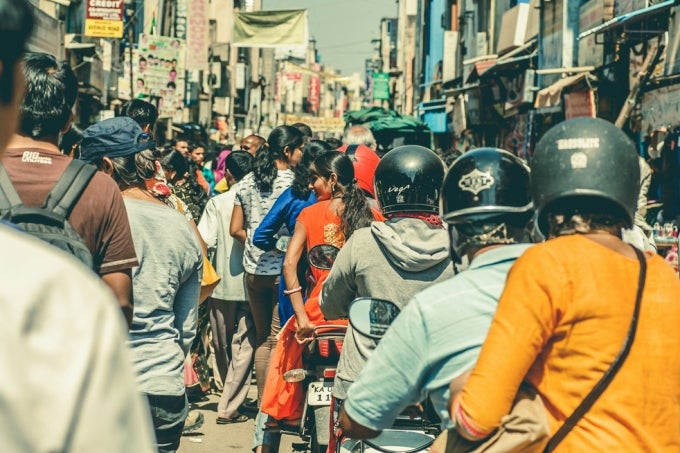
This blog is part of a series that discusses a way forward for South Asian regional integration.
That South Asia is brimming with possibilities for economic growth is well-known. It’s what drove us to write A Glass Half Full: The Promise of Regional Trade in South Asia. Our research shows that if South Asian countries lifted man-made barriers, intraregional trade could triple and unleash greater prosperity for all .
What we weren’t prepared for, however, was the overwhelmingly positive response the report received across the region. Government officials, members of the private sector, civil society, and particularly young people we met with were eager to learn more about how their countries could improve trade relations with their neighbors.
South Asia’s economic prospects are promising, but even more inspiring are its people who remain hopeful for change despite political circumstances that make it seem impossible.
In Pakistan, which suffers the biggest welfare loss because of non-cooperation, A Glass Half Full hit home in a variety of ways.
The country can increase its intraregional trade almost 8-fold, from $5.1 billion to $39.7 billion. This resounded with audiences at launch events in Islamabad, Lahore, and Karachi, evoking a sense of loss for the missed opportunity. They asked how Pakistan and other countries could amend their discriminatory policies and enjoy the benefits of free trade.
Politics often trumps economic cooperation in South Asia, but many in Pakistan suggested politics wins because the cost is so low. If intraregional trade were to increase, lobbies would arise to protect those interests.
A week before our report’s launch, Pakistan and India had initiated the Kartarpur border corridor to facilitate visa-free visits for Indian pilgrims to Pakistan’s Sikh holy sites. This had locals brainstorming more initiatives for regional integration. Students lined up after talks to chat, insisting that I come to speak at their universities- their enthusiasm was infectious.

Of course, many in Pakistan had concerns about opening up their economy. Especially to India. “Wouldn’t free trade with a much larger neighbor hurt us? Is trading with India useful since it produces the same goods as we do? Does India have any real incentive to trade with us?” But across the border, in India, A Glass Half Full was met with equal vigor.
People often assume India is reluctant to trade with its smaller neighbors. That, however, is not what we heard. Speaking at our launch event in Delhi, India’s Commerce Minister, Suresh Prabhu, said the government is prepared to do everything to realize India’s trade potential with South Asia . It could be $62.4 billion as opposed to $19.1 billion.
India’s border states, such as West Bengal and Punjab, have more to lose from the region’s non-cooperation than others. In Kolkata, audiences said states should be given a more active role in the making of policies regarding trade and economic cooperation. They hailed India’s border haats with Bangladesh, which allow for small-scale trade between communities along the two countries’ shared border, as a model to replicate with other neighbors.
Border haats were commended in Bangladesh as well, especially for the role they had played in increasing trust between the Bangladeshi and Indian border communities. Trade helps establish trust which leads to more trade, and trust can help deepen regional cooperation and make it more durable .
At A Glass Half Full’s Dhaka launch, Bangladesh’s then Finance Minister, AMA Muhith, said his country focuses on very distant markets in North America and Europe while opportunities at its doorstep remain unexplored. If barriers were lifted, Bangladesh’s trade with South Asia could increase from $7.6 billion to $18.9 billion.
Audiences resonated the same comments made in India’s border states. Bangladeshi agricultural products would become more expensive over time, they said, making integration with North East India necessary. Their earnestness only reinforced my belief that South Asia will integrate - it’s only a matter of time.
The liberalization of air services between Sri Lanka and India is another success story. Through gradual policy shifts since 2003, the two countries significantly improved bilateral air connectivity, a key facilitator of trade. This success has inspired several Sri Lankan companies to look towards India . It’s a high stakes market, said those who had succeeded in India, but the rewards make the attempts worthwhile.

At our launch in Colombo, the country’s Development Strategies and International Trade Minister, Malik Samarawickrama, said that with so much uncertainty surrounding global trade, regional trade integration provides a credible alternative. The government is working with agencies such as the Food Safety and Standards Authority of India to streamline procedures for accrediting Sri Lankan products and reduce non-tariff barriers to trade. Sri Lanka can more than double its exports to South Asia which are currently around $1.6 billion below potential .
Trade is a matter of survival for landlocked countries like Nepal, which can increase its exports to South Asia four-fold . The government wants to tackle the country’s trade deficit, but fears opening up would mean being overwhelmed by India.
At A Glass Half Full’s Kathmandu launch, Nepal’s Minister for Finance, Dr. Yuba Raj Khatiwada, said his country would liberalize trade, but with caution. They would focus on complementarity and export goods and services in which the country has a clear comparative advantage.
Other experts said external engagement is not a matter of choice for Nepal, it is the only option. They cited Singapore, Rwanda, and the Netherlands as examples of small countries punching above their weight because of effective trade policies.
Students I spoke to were invigorated. Since protectionism is so popular in Nepal, they said they did not have much exposure to arguments for free trade.
Young people like them are South Asia’s greatest asset, and the more I engage with them the more confident I feel that they will help steer the region towards its undoubted potential.


Join the Conversation